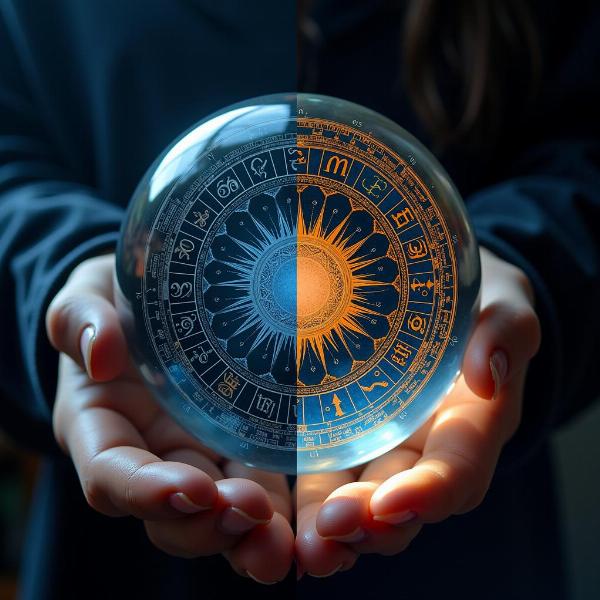Crystal gazing, a practice shrouded in mystique, often evokes images of veiled figures peering into shimmering spheres. But what exactly does “crystal gazer” mean in Hindi? This article delves into the Hindi translations, cultural context, and significance of this intriguing term. We’ll explore the practice itself, its historical roots in India, and its place in modern Indian society.
Unveiling the Hindi Translations of Crystal Gazer
The term “crystal gazer” translates to several Hindi phrases, each carrying its own nuance. The most common translation is “क्रिस्टल दर्शी” (kristal darshi), which literally means “crystal seer.” This emphasizes the act of seeing or perceiving through the crystal. Another translation is “स्फटिक भविष्यवक्ता” (sphatik bhavishyavakta), meaning “crystal fortune teller.” This emphasizes the predictive aspect of crystal gazing, associating it with prophecy. Finally, “माणिक दर्शी” (manik darshi), though technically referring to a “gem seer,” can also be used in a broader context to include crystal gazing, reflecting the traditional Indian association of gems with mystical powers.
Crystal Gazing in Indian Culture: A Historical Perspective
Crystal gazing has a long and storied history in India, intertwined with ancient spiritual practices and traditions. From Vedic seers to Mughal emperors, crystal balls and other reflective surfaces have been used as tools for divination and self-discovery. These practices are often linked to Hindu and Buddhist philosophies, particularly the concept of accessing hidden knowledge and future insights through meditation and focused concentration. Historically, crystal gazers held positions of respect within royal courts and religious communities, consulted for guidance on matters of state and personal dilemmas.
The Modern Relevance of Crystal Gazing in India
While the practice might seem archaic in the digital age, crystal gazing continues to hold a place in modern Indian society. While skepticism exists, many still consult crystal gazers seeking guidance on matters of love, career, and finances. This enduring fascination speaks to a deep-seated cultural belief in the interconnectedness of the spiritual and material worlds. Moreover, crystal gazing can be seen as a form of introspection, a way to connect with one’s intuition and inner wisdom.
What Does a Crystal Gazer Do?
A crystal gazer uses a clear quartz crystal ball, or sometimes other reflective surfaces, as a focal point for meditation and divination. They aim to achieve a trance-like state, allowing images and insights to emerge from the depths of their subconscious or, as some believe, from the spiritual realm. These images are then interpreted to provide guidance or predict future events. It’s crucial to understand that crystal gazing is not about predicting the future with certainty, but rather about exploring potential outcomes and gaining a deeper understanding of oneself and the world around them.
Crystal Gazer vs. Astrologer: Key Differences
While both crystal gazers and astrologers are consulted for guidance, their methods differ significantly. Astrologers base their predictions on the positions of celestial bodies, while crystal gazers rely on intuition and interpretation of images perceived within the crystal. One focuses on cosmic influences, the other on inner perception. Both practices have their own unique place within Indian culture, offering different approaches to seeking guidance and understanding.
 Crystal Ball and Astrology Chart
Crystal Ball and Astrology Chart
Conclusion: The Enduring Allure of Crystal Gazing
“Crystal gazer meaning in Hindi” encapsulates more than just a translation. It represents a rich cultural history and a continuing fascination with the unseen. Whether viewed as a spiritual practice, a form of introspection, or simply a cultural curiosity, crystal gazing offers a glimpse into the enduring human desire to understand the mysteries of life and the future.
FAQs
- Is crystal gazing scientifically proven? No, crystal gazing is not scientifically proven and is generally considered a pseudoscience.
- Is crystal gazing a religious practice? While associated with certain spiritual traditions, crystal gazing itself is not a religious practice.
- How can I learn crystal gazing? There are resources available online and in print that offer guidance on crystal gazing techniques.
- Is it expensive to consult a crystal gazer? The cost of consulting a crystal gazer varies widely.
- Are all crystal gazers accurate? The accuracy of a crystal gazer is subjective and based on individual beliefs and experiences.
- What type of crystal is used for crystal gazing? Clear quartz is the most commonly used crystal for crystal gazing.
- Is crystal gazing harmful? Crystal gazing itself is not considered harmful, but it’s important to maintain a balanced perspective.
Meaning-Hindi.in is your trusted partner for professional Hindi translation services. We specialize in a wide range of translation needs, including business and commercial documents, legal and certified translations, technical manuals, website localization, educational and academic materials, and expedited translation services. Whether you need to translate your business documents into Hindi or require interpretation services, our team of expert linguists ensures accurate and culturally sensitive translations. Contact us today for a personalized quote! Email: [email protected], Phone: +91 11-4502-7584. Meaning-Hindi.in is your gateway to bridging language barriers and connecting with the Indian market.